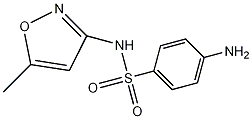
Structural formula
| Business number | 07FH |
|---|---|
| Molecular formula | C10H11N3O3S |
| Molecular weight | 253.28 |
| label |
sulfamethoxazole, Xinmingsulfonate, Sulfamethoxazole, 4-amino-N-(5-methyl-3-isoxazolyl)benzenesulfonamide, 3-p-aminobenzenesulfonamide-5-methyloxazole, 3-(P-Aminophenylsulfonamido)-5-Methylisoxazole, 4-Amino-N-(5-methyl-3-isoxazolyl)benzenesulfonamide, N1-(5-Methylisoxazol-3-yl)sulfanilamide, Antibacterial agents |
Numbering system
CAS number:723-46-6
MDL number:MFCD00010546
EINECS number:211-963-3
RTECS number:WP0700000
BRN number:6732984
PubChem number:24899752
Physical property data
1. Properties: White crystalline powder, odorless and slightly bitter.
2. Density (g/mL, 25/4℃): Undetermined
3. Relative vapor density (g/mL, air=1): Undetermined
4. Melting point (ºC): 167
5. Boiling point (ºC, normal pressure): Undetermined
6. Boiling point (ºC, 5.2kPa): Undetermined
7. Refractive index: Undetermined
8. Flash point (ºC): Undetermined
9. Specific rotation (º): Undetermined
10. Autoignition point or ignition temperature (ºC): Undetermined
11. Vapor pressure (kPa, 25ºC): Undetermined
12. Saturated vapor pressure (kPa, 60ºC): Undetermined
13. Heat of combustion (KJ/mol): Undetermined
14. Critical temperature (ºC): Undetermined
15. Critical pressure (KPa): Undetermined
16. Log value of oil-water (octanol/water) partition coefficient: Undetermined
17. Explosion upper limit (%, V/V) : Undetermined
18. Lower explosion limit (%, V/V): Undetermined
19. Solubility: Easily soluble in dilute hydrochloric acid, sodium hydroxide solution or ammonia, almost Insoluble in water.
Toxicological data
irritating
Ecological data
Slightly hazardous to water. Do not allow undiluted or large quantities of product to come into contact with groundwater, waterways or sewage systems. Do not discharge materials into the surrounding environment without government permission
Molecular structure data
1. Molar refractive index: 62.45
2. Molar volume (cm3/mol): 173.1
3. Isotonic specific volume (90.2K): 502.3
4. Surface tension (dyne/cm): 70.9
5. Dielectric constant:
6. Dipole moment (10-24cm3):
7 , Polarizability: 24.75
Compute chemical data
1. Reference value for hydrophobic parameter calculation (XlogP): None
2. Number of hydrogen bond donors: 2
3. Number of hydrogen bond acceptors: 6
4. Number of rotatable chemical bonds: 3
5. Number of tautomers: 2
6. Topological molecule polar surface area 107
7. Number of heavy atoms: 17
8. Surface charge: 0
9. Complexity: 346
10. Number of isotope atoms: 0
11. Determine the number of atomic stereocenters: 0
12. Uncertain number of atomic stereocenters: 0
13. Determine the number of chemical bond stereocenters: 0
14. Number of uncertain chemical bond stereocenters: 0
15. Number of covalent bond units: 1
Properties and stability
None
Storage method
Stored in a cool, dry place and away from light
Synthesis method
1. Using 5-methylisoxazole-3-carboxamide as raw material, it is degraded to 5-methylisoxazole-3amine under the action of sodium hypochlorite, and then condensed with p-acetamidobenzenesulfonyl chloride to form 3 -(p-acetamidobenzenesulfonamide)-5-methylisoxazole, and then hydrolyzed under alkaline conditions to obtain 3-(p-aminobenzenesulfonylamino)-5-methylisoxazole. Obtained from 5-methylisoxazole-3-carboxamide through degradation, condensation and hydrolysis
2.Esterified from oxalic acid and ethanol , condensation, cyclization and amination with acetone and sodium methoxide to obtain 3-amino-5-methylisoxazole, which is then condensed with acetaminophenyl chloride and refined by hydrolysis.
Purpose
1. As an antibacterial agent, it is particularly effective against Staphylococcus aureus and Escherichia coli. It is mainly used as an anti-infective drug to treat avian cholera, and is used to prevent urinary tract infections, respiratory tract infections, intestinal infections, salmonella infections, acute otitis media in children, and meningococcal meningitis. Sulfa drugs are mainly used to treat acute and chronic urinary tract infections. They can also be used to prevent meningitis and acute otitis media caused by influenza bacilli. They can inhibit the growth of bacteria and are particularly effective against Staphylococcus and Escherichia coli. They can also be used to treat urinary tract infections. Infection and poultry littering are effective in biochemical studies. Medicine (antibacterial drugs) 2.Broad antibacterial spectrum, strong antibacterial effect, especially effective against Staphylococcus aureus and Escherichia coli. Suitable for respiratory system, urinary system and intestinal infections. It can hinder the growth of bacteria and is particularly effective against Staphylococcus aureus and Escherichia coli. Mainly used to treat avian cholera, etc.

 微信扫一扫打赏
微信扫一扫打赏

